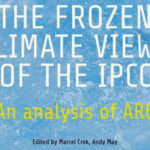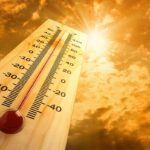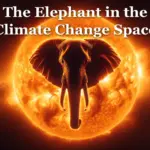‘The science is settled. All scientists agree.’ Hoe vaak hebben we dat niet vanuit de mainstream der klimatologie gehoord? Maar dit was en is je reinste klimaatpropaganda. Hoe is men er toch in geslaagd de politiek en het publiek zo’n lange tijd met dat sprookje voor de gek te houden?
Dat is mede gelukt door de stelselmatige excommunicatie door de mainstream klimatologie van wetenschappers, waaronder toppers, die aantoonden dat de CAGW–hypothese (‘CAGW = ‘Catastrophic Anthropogenic Global Warming’) niet klopte.
De website ‘Die Kalte Sonne’ van Fritz Vahrenholt en Sebastian Lüning publiceerde onlangs een aantal voorbeelden van de duistere praktijken die in de loop der jaren achter de schermen op het onderhavige terrein hebben plaatsgevonden.
Onder de titel, ‘Lichtblick: European Association of Geoscientists & Engineers (EAGE) veröffentlicht Kritik am Klimaalarmismus’, schreven zij:
Es ist kein Geheimnis, dass ein Großteil der Geowissenschafler das Konzept der Klimakatastrophe ablehnen. Da jedoch viele Geologen und Geophysiker aus Angst um ihren Job öffentlich zum Thema schweigen, haben Physiker und Mathematiker mit ihren windigen Computermodellen die mediale Deutungshoheit inne. Als sich vor anderthalb Jahrzehnten die Bundesanstalt für Geowissenschaften und Rohstoffe (BGR) einmal traute, das Thema realistisch zu diskutieren, waren die Folgen für die Beteiligten verheerend. Direktoren wurden ausgewechselt und von Regierungsseite mit politischen Verbündeten ersetzt, Arbeitsgruppen aufgelöst und Karrieren zerstört. Schnell wurde klar, dass eine ergebnisoffene, wissenschaftliche Diskussion in der Öffentlichkeit nicht gewünscht, sogar nicht erlaubt war, wollte man nicht beruflich Kopf und Kragen riskieren. Siehe unsere Zusammenfassung “Pioniere des Klimarealismus: Die Bundesanstalt für Geowissenschaften und Rohstoffe (BGR)“.
Zur gleichen Zeit glaubte auch ein Heidelberger Klimawissenschaftler an die Überzeugungskraft von harten Fakten und wagte es doch tatsächlich, die starke natürliche Variabilität der vorindustriellen Zeit und die erkannten Muster in die Diskussion einzubringen. Wiederum wurden die Kampfhunde losgelassen und eine mediale Vernichtungskampagne initiiert. Der Fall Mangini wurde schnell erledigt (siehe “Prof. Augusto Mangini – Ein Pionier des Klimarealismus“), der Querulant aus dem Weg geschafft.
Voorts schenken de auteurs aandacht aan de geochemicus Jan Veizer die op basis van paleoklimatologisch onderzoek tot de conclusie kwam dat CO2 slechts een ondergeschikte rol speelde in de temperatuurfluctuaties in het verleden. Later werkte hij samen met de astrofysicus Nir Shaviv. Samen schreven zij een artikel waarin zij een belangrijke rol toeschreven aan fluctuaties in kosmische straling. Zij werden scherp bekritiseerd door de Duitse klimaattorquemada, Stefan Rahmstorf, van het ‘Potsdam Institut für Klimafolgenforschung’ (PIK).
In hun boek ‘Die kalte Sonne’ sloten Fritz Vahrenholt en Sebastian Lüning zich aan bij degenen die van mening waren dat de klimaatgevoeligheid betrekkelijk laag was (lager dan het VN-klimaatpanel destijds aanhield). Bij een verdubbeling van de CO2–concentratie in de atmosfeer zou deze volgens hen 1,5 graden C bedragen. Daarmee schaarden zij zich onder de zogenoemde ‘lukewarmers’. Vele klimaatsceptici zijn van mening dat de klimaatgevoeligheid nog aanzienlijk lager ligt. De discussie daarover woedt voort.
Vahrenholt en Lüning werden daarvoor destijds door het klimaatestablishment flink afgestraft. Twee jaar later werd Lüning nochtans uitgenodigd door een bestuurslid van een van de grootste Duitse geowetenschappelijke organisaties om zijn stelling te verdedigen in het blad voor leden. Hij schrijft daarover:
Lüning erstellte das eingeladene Manuskript – und wartete. Und wartete und wartete. Die vormals so emailfreudige Kontaktperson aus der Verbandsleitung schaltete plötzlich auf stumm. Nachfragen zwecklos. Schließlich veröffentlichten wir den Artikel einfach hier im Blog (“Klimawandel in Deutschland: Eine geowissenschaftliche Betrachtung“).
Zu gerne hätten wir gewusst, was hier hinter den Kulissen passiert ist. Wer hat sich hier quer gestellt? Gab es politischen Druck, vielleicht Drohungen hinsichtlich der weiteren Karriereentwicklung der Beteiligten? Man weiß es nicht.
In November 2015 was er toch reden om de vlag uit te steken. De ‘European Association of Geoscientists & Engineers’ (EAGE), die 19.000 leden telt, publiceerde een artikel van hun lid, Bob Heath.
De volgende passage is uit de inleiding van zijn artikel (trouwe lezers zullen de stokpaardjes van David Dirkse, regelmatige coauteur en respondent van dit blog, herkennen):
Unsettling Science
The scientific method and hydrocarbon propensity.
The scientific method is perhaps humanity’s greatest achievement, laying the foundation for the industrial revolution which, for some, improved living standards to unimaginable levels. It led to the harnessing of fossil fuels providing far more energy than a single person ever had at their disposal before, increasing prosperity in the process. There are direct relationships between per capita CO2 output and standard of living indices such as child mortality/life expectancy, and available funds for environmental protection. Almost every social advancement has relied on electricity generated with the fossil fuels our profession helps to locate and, despite costly drives towards renewables, 87% of world energy in 2013 still came from hydrocarbons. For 150 years there have been claims that fossil fuels have peaked. William Jevons in the 1860s forecast that Britain would quickly run out of coal, leading him to conclude that the country’s ‘present happy progressive condition’ would be of limited duration. But largely thanks to geoscientists, we enjoy ongoing supplies enabling affluence to expand. Despite demonisation by environmentalists, civilisation will depend on hydrocarbons for most of our foreseeable power needs permitting us to continue escaping Malthusian limitations. Imagine a world where Jevons was right and we had run out of hydrocarbons during the reign of Queen Victoria. Would standards of living have gone on increasing and how would the environment have suffered?
In het artikel zelf (achter een hoge betaalmuur) worden de bekende argumenten tegen de AGW–hypothese op een rijtje gezet.
Enkele krenten:
In the second AR many key scientific sections were deleted, e.g. ‘No study to date has positively attributed all or part [of observed climate change] to anthropogenic causes’. The IPCC did not deny these deletions, saying changes had been made under pressure from governments. It ended up with: ‘The balance of evidence suggests a discernible human influence on global climate’. Prof. Frederick Seitz wrote ‘In my more than 60 years as a member of the American scientific community, including service as president of both the National Academy of Sciences and the American Physical Society, I have never witnessed a more disturbing corruption of the peer review process than the events which led to this IPCC report.’
En dan de beroemde passage uit het rapport van 1997, waarin het VN–klimaatpanel (IPCC) de bijl legt aan de wortel van de AGW–hypothese, maar de implicaties daarvan negeert en vervolgens weer snel overgaat tot de orde van de dag:
But AR3 admitted ‘we are dealing with a coupled-nonlinear chaotic system, and therefore long-term prediction of future climate states is not possible’, and the ludicrous assumption is made that natural variation is understood.
Aangenomen mag worden dat vele leden op dit artikel van Bob Heath hebben gereageerd. Maar slechts twee lezersbrieven werden afgedrukt, waaronder de navolgende:
Dear Editor,
Many thanks to Bob Heath and the publishing team at EAGE for the brilliant article about climate change in First Break 11-2015. As an exploration geophysicist in the E&P industry I have believed in the scientific approach of climate sciences in the 1980th and held the media hype for the usual public presentation of extreme results, well known from my own business in land seismic acquisition. In the 1990th I have regret the absence of well-established paleoclimate knowledge in the medial presentation of the feared climate catastrophe to the public. And in the 2000th I had to realize that climate sciences denied proven paleoclimate facts and claimed “the end of the debate” for their “settled science” of climate change. That forced me after retirement to write a book about the connection between geology and climate succession which, honestly spoken, nobody is willing to read.
Through all my professional days in the industry the fairytale of the future climate catastrophe was a permanent source of amusement among geo-scientists. But this amusement was not mirrored back into the frightened public. On the contrary, through that course of growing public panic about the future climate progression, geo-scientist felt increasingly isolated with their scientific arguments in their own private environment.
Today, political decisions have been already made, billions of Dollars have been spend for deviant future climate models and organisations have risen to enforce the aimed decarbonisation of the world. Facing the future destruction of our industry by climate alarmists, we may doubt whether we have used our scientific knowledge about paleoclimate well enough to serve the frightened public.
“The debate is over” – and we all have played a role in the silence of the lambs …
With best regards
Ulrich O.Weber
Aldus Fritz Vahrenholt en Sebastian Lüning op hun website ‘Die Kalte Sonne’.
Lees verder hier.
De Lysenkoïstische druk van de kant van mainstreamklimatologen, waaraan de klimaatsceptici hebben blootgestaan en nog steeds bloot staan, verwacht men eerder in landen als de voormalige Sovjet–Unie, Noord–Korea en Iran, maar niet in het ‘Vrije Westen’. Maar gelukkig, de Augiasstal wordt toch langzaam gereinigd, zij het dat de hierboven beschreven aanzet uit de geowetenschappen komt en niet vanuit de mainstreamklimatologie.
Voor mijn eerdere bijdragen over klimaat en aanverwante zaken zie hier, hier, hier, hier en hier.






Schokkende citaten.
God is een ander woord voor het onbekende. Religie geeft traditioneel antwoorden op vragen over het onbekende. De verlichting werd mogelijk door hemel en aarde te scheiden. Wetenschap is wat we wel kunnen onderzoeken. Religie en wetenschap zijn complementair.
Thans zien we regressie naar een theocratie. De Groene Kerk bemoeit zich met aardse technologie. Het onbegrepen klimaat levert de nieuwe hel, pest en duivels.
Kuddevee houd je in bedwang met dreigingen.
Primitieve volkeren moeten vlug leren rekenen als ze met onze beschaving in aanraking komen. Anders worden ze door handelaren uitgeknepen.
Maar in het algemeen wordt iedereen die niet kan of wil denken gepakt.
De mainstream klimaatwetenschap zegt in essentie dat waarnemingen ten aanzien van de ontwikkeling van het klimaat (de opwarming) alleen verklaard kunnen worden door antropogene componenten mee te nemen in de beschouwing. Wanneer de antropogene componenten worden weggelaten, dan is er geen verklaring mogelijk van de waarnemingen.
Grafisch overzicht van de betekenis van bovenstaande:
https://www.ipcc.ch/publications_and_data/ar4/syr/en/fig/figurespm-4-l.png
Joris van Dorp,
De toelichting op deze grafieken bevat een cirkelredenering. Dat is een doodzonde in de wetenschap. Het is veelzeggend dat de auteurs – de crème de la crème van de klimatologie – dat over het hoofd hebben gezien.
Waarbij geen rekening is gehouden met de 3,5 miljoen onderzeese vulkanen. Waarbij ook de invloed van de zon onbegrepen is.
Waarbij bedacht moet worden dat vorige interglacialen warmer waren dat de huidige maar dat desondanks nieuwe ijstijden zijn ingetreden.
En als CO2 de hoofdschuldige (aan opwarming) zou zijn dan is de remedie van de milieuactivisten niet te verklaren: kernenergie en hydro in de ban. Wel keuze voor onbetrouwbare en onvoldoende energie. De enige verklaring is een verborgen agenda: terug naar een pré-industriëel tijdperk.
Waren er voordat de mens kolen en olie ging opstoken geen temperatuur veranderingen?
In de 21ste eeuw zou je verwachten dat de kritische wetenschappelijke methode zou prevaleren. We hebben het helemaal mis. Er zijn andere mechanismen aan het werk. Daarbij spelen de volgende zaken een belangrijke rol: Democratie, Internet/media, gemakszucht en PR.
Democratie is fantastisch, maar het gaat om de uitvoeringsvorm. Zelfs onze parlementaire democratie is verdedigbaar maar als dit er enerzijds toe leidt dat de burger stopt met nadenken omdat je dat gedelegeerd hebt en anderzijds dat de parlementariers ook te lui en onkundig en beïnvloed door lobbyisten zijn om dat te doen, reken je je rijk terwijl je met lege handen achterblijft.
De traditionele media spelen hierin een dubieuze rol. Hun voorkeur voor stichterlijke sensatie wordt perfect bediend met ‘verantwoord’ wijzen op vermeende gevaren. Uiteraard precies de ‘gevaren’ die hen door hun bazen zijn aangewezen.
Gelukkig kun je op het Internet wat flexibeler je bron kiezen dan wanneer je na het nieuws naar Gerrit Hiemstra kijkt. De meeste burgers worden echter gedreven door gewoonte en gemakszucht, dus hebben de eendimensionale media een gigantisch voordeel.
Wat is hierbij de rol van wetenschap? Goeie vraag.
Beste Jan,
Over de mechanismes die hier aan het werk zijn, eigenlijk altijd weer, over and over again, beveel ik ook aan:
https://en.wikipedia.org/wiki/Moral_panic
Hieronder vallen m.i. ook de millenniumbug, de koude oorlog, eugenics, de tweede wereldoorlog, russische revolutie, heksenjachten, kruistochten, etc. Het mechanisme is altijd hetzelfde, de grote charismatische narcistische held (en) wijst een vijand aan die de ongeschoolde massa met volle overgave bestrijdt.
Eén en ader is een eeuw geleden al samengevat door H.L. Mencken:
Goeie link. Geen idee dat er kennelijk al zoveel onderzoek naar is gedaan. Bevestigt overigens mijn vermoeden dat je de oplossing niet in de betahoek moet zoeken maar in die van communicatie, psychologie en journalistiek.
Ik herinner me in dat verband trouwens een verkiezingsbijeenkomst waarbij aan Joop de Uyl gevraagd werd wat hij dacht te doen tegen de almaar stijgende misdaadgolf. Zijn antwoord was: “Een andere ochtendkrant lezen”.
Kijk ook hier:
http://joannenova.com.au/
http://jonova.s3.amazonaws.com/sh1/the_skeptics_handbook_2-3_lq.pdf
En kijk dan naar bladzijde 12: How to create a crisis graph.
http://jonova.s3.amazonaws.com/sh2/the_skeptics_handbook_IIj-sml.pdf
This is argumentum ad ignorantiam — essentially
they say: we don’t know what else could have
caused that warming, so it must be carbon. It’s a
flawed assumption.